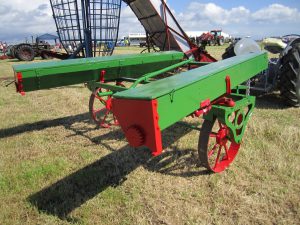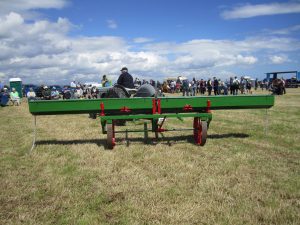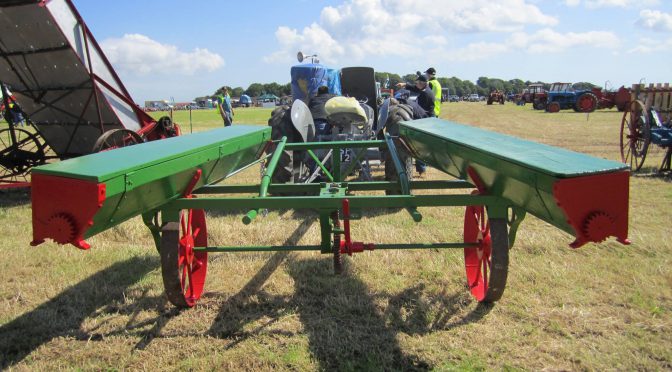By 1908 there were various forms of broadcast sowers available to the farmer.
In that year Henry Stephens suggested that the one made by Ben. Reid & Co., Aberdeen, “exhibits the machine in the most perfect form.” He adds: “this machine not only does the work well, but it is so constructed that its long sowing-chest is divided into sections, the two end ones of which can be folded upon the central division,  whereby it may pass through any field-gate without the sowing-chest having to be removed. The sowing-gear of the broadcast machine is connected with the main axle of the carriage. The arrangements for regulating the quantity of seed per acre are very simple and effective, and altogether the machine is very easily worked and controlled. About 18 feet is the usual width sown at once by the machine.”
whereby it may pass through any field-gate without the sowing-chest having to be removed. The sowing-gear of the broadcast machine is connected with the main axle of the carriage. The arrangements for regulating the quantity of seed per acre are very simple and effective, and altogether the machine is very easily worked and controlled. About 18 feet is the usual width sown at once by the machine.”
Stephens describes how machine sowing of grass was undertaken. He writes that the grass-seed broadcast sowing machine “has superseded the necessity of hand-sowing on most farms. This is a most perfect machine for sowing grass seeds, distributing them with the utmost precision, and to any amount, and so near the ground that the wind affects but little even the lightest grass seed. Its management is easy when the ground is ploughed in ordinary ridges. The horse starts from one head-ridge, and walks in the open furrow  to the other, while the machine is sowing half the ridge on each side, the driver walking in the furrow behind the machine, using double reins. On reaching the other head-ridge, the gearing is put out of action till the horse, on being hied, enters the next open furrow on the head-ridge; and on the gearing being again put on, the half of a former ridge is sown, completing it with the half of a new one by the time the horse reaches the head-ridge he started from. Thus 2 half-ridges after 2 half-ridges are sown until the field is all covered.
to the other, while the machine is sowing half the ridge on each side, the driver walking in the furrow behind the machine, using double reins. On reaching the other head-ridge, the gearing is put out of action till the horse, on being hied, enters the next open furrow on the head-ridge; and on the gearing being again put on, the half of a former ridge is sown, completing it with the half of a new one by the time the horse reaches the head-ridge he started from. Thus 2 half-ridges after 2 half-ridges are sown until the field is all covered.
The seed is supplied from the head-ridge, upon which the sacks containing it were set down when brought from the steading.
The head-ridges are sown by themselves. But the half of the ridge next the fence on each side of the field cannot be reached by the machine, and must be sown by hand.
When ridges are coupled together, the horse walks along the middle between the crown and open furrow, the furrow-brow being the guide for one end of the machine, and 2 ridges are thus sown at every bout. Where ridges are ploughed in breaks of 4 ridges in width, the furrow-brow is the guide in going and the crown in returning, while sowing 2 of the ridges; and the crown in going and the furrow-brow in returning, while sowing the other 2 ridges.”
A revolution in grass-sowing!
The photographs of the Garvie broadcast drill were taken at the Fife Vintage Rally, June 2014.
© 2016 Heather Holmes
